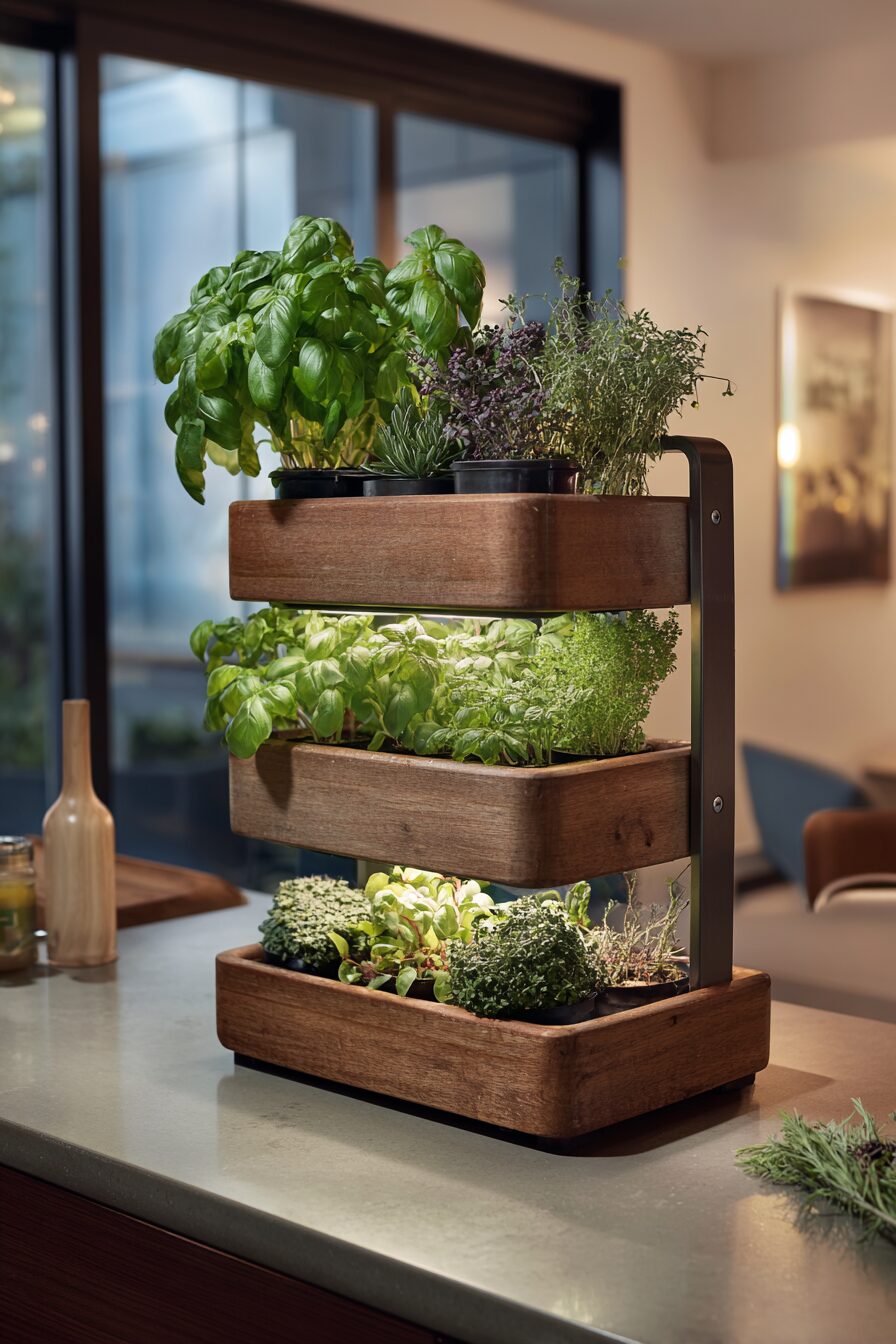Fresh herbs can completely transform your cooking, but when you’re working with a small kitchen, finding space for a garden feels impossible.
The good news is that you don’t need acres of space or even a backyard to grow your own basil, thyme, and cilantro – you just need to get creative with the space you already have.
Vertical Wall-Mounted Herb Planters That Double as Kitchen Art
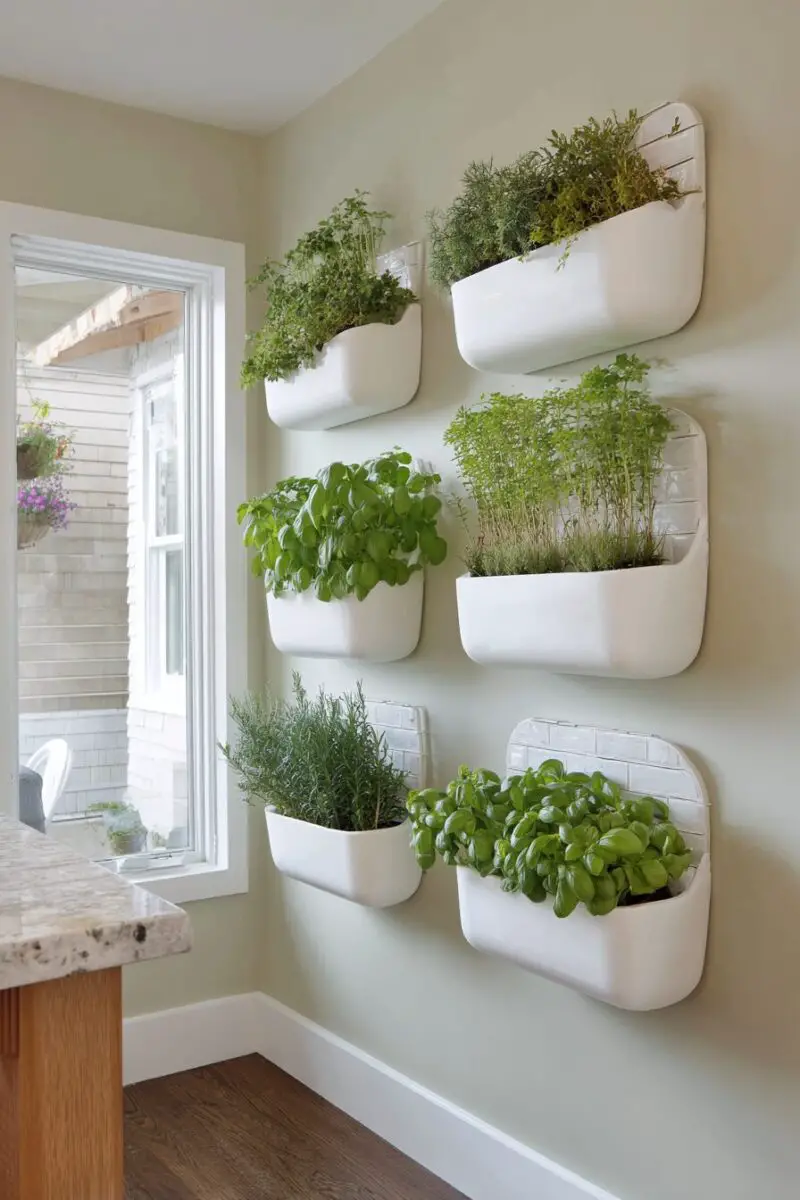
Your blank kitchen wall is actually prime real estate for a stunning herb garden that’ll make your neighbors jealous.
Wall-mounted vertical planters create an impressive living wall that takes up zero counter space while giving you easy access to fresh herbs.
You can install a series of pocket planters made from felt or canvas that hang like a tapestry, creating multiple growing spaces in the footprint of a single picture frame.
These systems work particularly well because they allow you to group herbs by their watering needs – Mediterranean herbs like rosemary and oregano in the top pockets where drainage is better, and moisture-loving herbs like basil and parsley in the lower sections.
The visual impact is incredible, turning what used to be dead wall space into a lush, green focal point that makes your kitchen feel like a high-end restaurant.
Installation is straightforward with basic wall anchors, and most vertical systems come with built-in water collection trays to protect your walls from moisture damage.
You can even mix in some trailing herbs like thyme or oregano that’ll cascade down beautifully, creating layers of texture and interest.
The best part about this setup is that you can easily rearrange plants as they grow or as your cooking preferences change throughout the seasons.
Many vertical systems are modular, so you can start small with just a few pockets and expand your herb collection over time without having to reinstall everything.
For renters, there are plenty of removable options that use tension rods or adhesive strips instead of permanent mounting hardware.
The key to success with vertical gardens is choosing the right location – you’ll want a spot that gets at least 4-6 hours of indirect sunlight daily and is easily accessible when you’re cooking.
Window Sill Herb Strips for Maximum Sun Exposure

Your kitchen window sill is the most underutilized growing space in your entire home, and it’s time to change that.
Window sill herb gardens take advantage of natural light while keeping your herbs within arm’s reach of your cooking space.
You can create a custom herb strip by using long, narrow planters that span the entire length of your window, maximizing every inch of available space.
These planters work best when they’re shallow and wide rather than deep, allowing you to fit multiple herb varieties while ensuring each plant gets adequate light exposure.
The beauty of window sill gardening is that you can easily monitor your plants’ water needs and growth progress since you’ll see them every time you look outside.
Choose herbs that complement each other in terms of height and growing habits – place taller herbs like rosemary or sage toward the back, with shorter varieties like chives and parsley in front.
You’ll want planters with excellent drainage since window sills can get quite warm during sunny days, causing soil to dry out quickly.
Window herb gardens also benefit from the natural temperature regulation that comes from being near glass – they stay warmer in winter and get good air circulation in summer.
For windows that face different directions, you can select herbs accordingly: south-facing windows are perfect for Mediterranean herbs that love intense sun, while east or west-facing windows work well for more delicate herbs like cilantro and dill.
If your window sill is particularly narrow, look for clip-on planters that attach directly to the window frame, extending your growing space without taking up any actual sill real estate.
The convenience factor here is unbeatable – you can literally snip fresh herbs while you’re washing dishes or preparing meals.
Design Your Dream Room in Minutes!
🏡 Start Creating FREE →Magnetic Herb Planters That Stick to Your Refrigerator
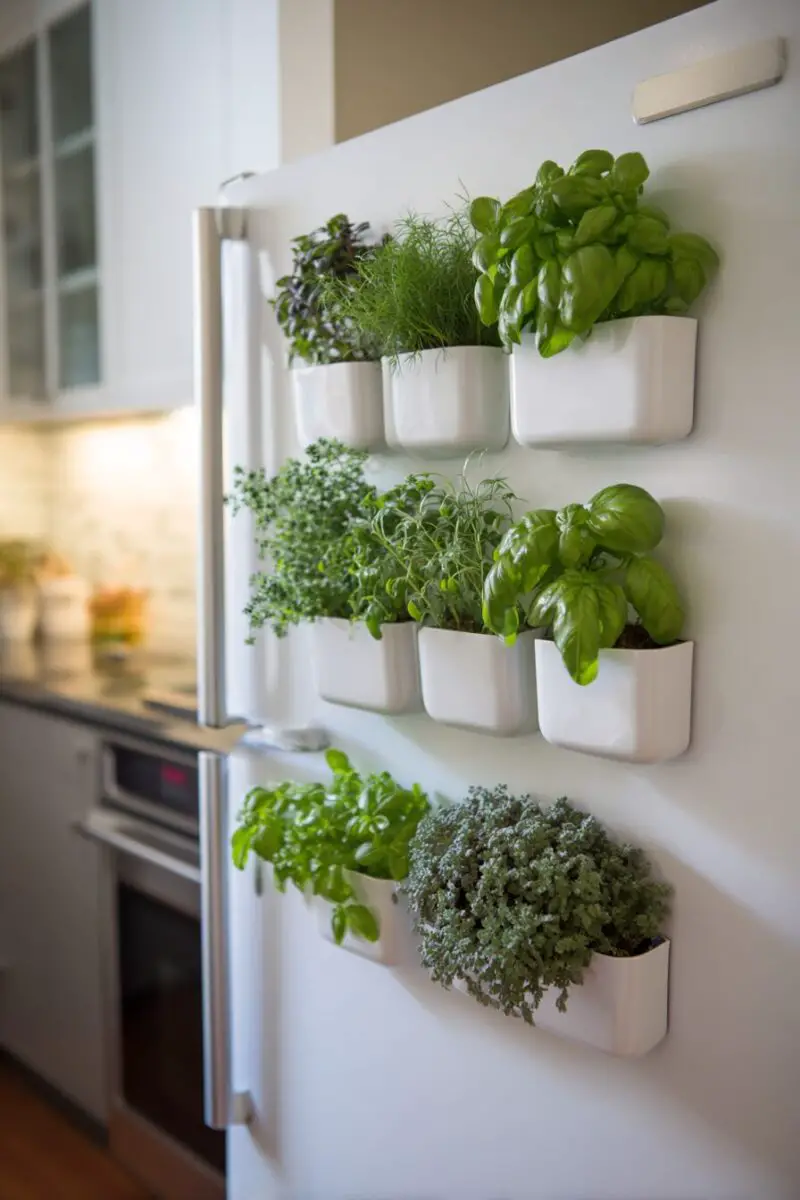
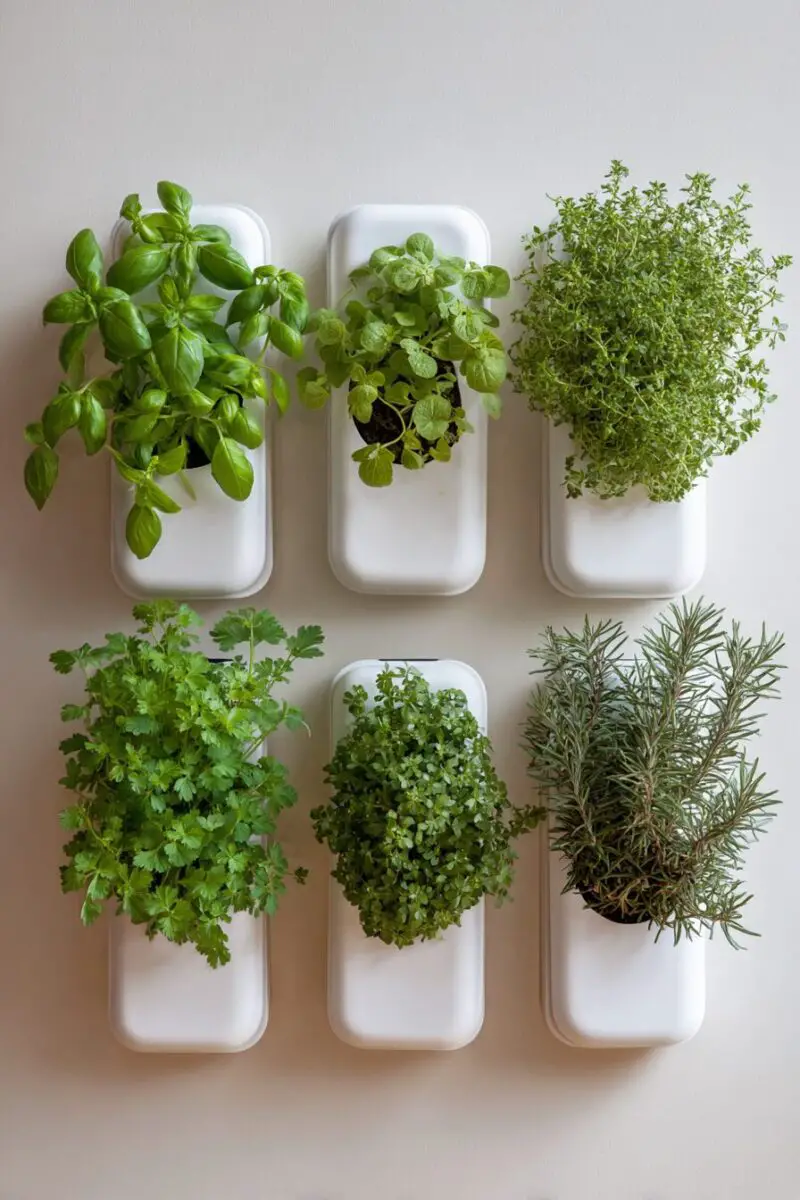
Your refrigerator’s side panel is valuable vertical real estate that’s begging to become a thriving herb garden.
Magnetic planters offer the ultimate in space-saving convenience, turning the outside of your fridge into a living spice rack that’s always within reach.
These clever containers use strong neodymium magnets that can hold several ounces of soil and a growing plant without sliding down or falling off.
You can arrange them in patterns that make visual sense – perhaps a neat grid for an organized look, or a more organic clustering that mimics how herbs might grow in nature.
The constant gentle vibration from your refrigerator’s compressor actually helps with root aeration, promoting healthier plant growth than you might expect.
Since refrigerators generate some heat, especially around the sides and back, your herbs will enjoy slightly warmer conditions that many varieties prefer.
Magnetic planters work particularly well for smaller herbs like oregano, thyme, and small basil varieties that don’t require deep root systems.
You can easily rearrange your garden layout as plants grow or as you add new varieties, making this one of the most flexible indoor gardening solutions.
The key to success with magnetic herb gardens is choosing planters with proper drainage – look for designs that include drip trays or self-watering systems to protect your floor.
Many magnetic planters come with chalkboard labels or writable surfaces, so you can keep track of what you’ve planted and when you planted it.
This setup is particularly brilliant for renters since it requires zero installation and leaves no marks or holes when you move.
You can even take this concept further by using the sides of other metal appliances like dishwashers or range hoods, creating a comprehensive kitchen herb ecosystem.
Under-Cabinet Hanging Herb Gardens for Hidden Growing Space
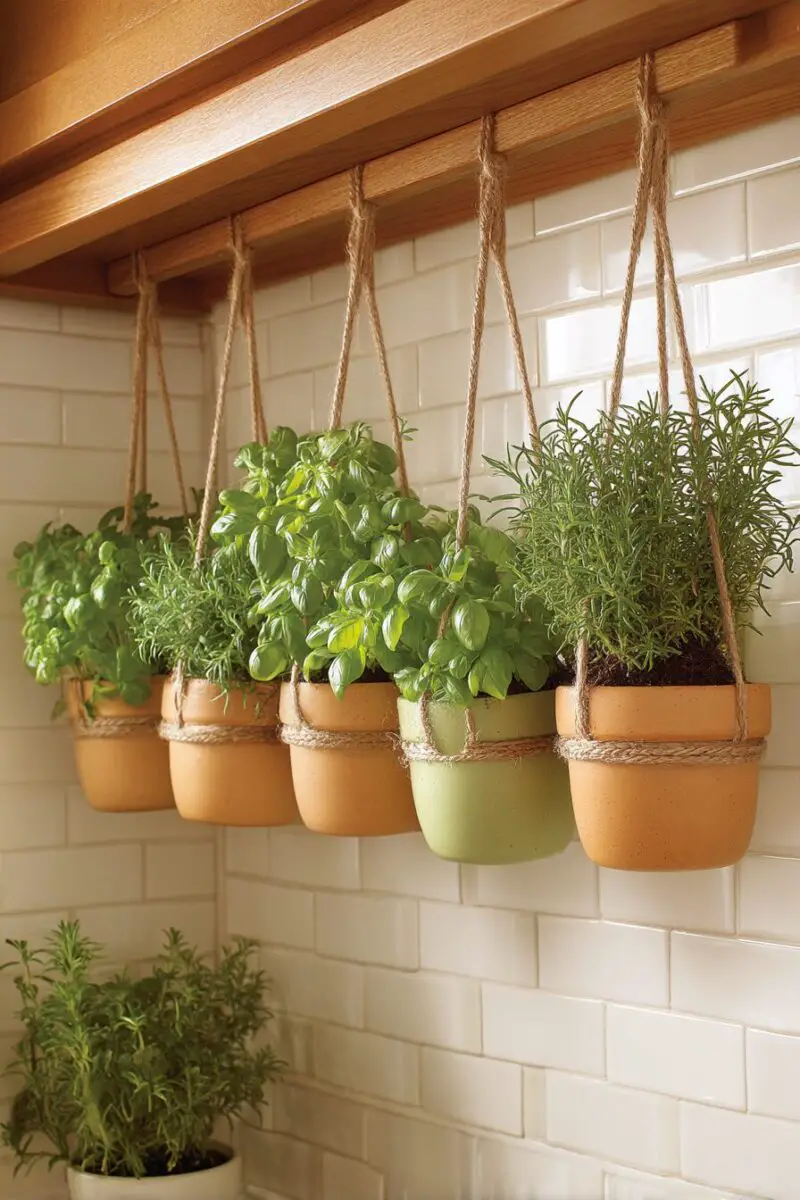
The space underneath your upper cabinets is a goldmine for herb growing that most people completely overlook.
Under-cabinet herb gardens utilize this hidden area to create a thriving growing space that doesn’t interfere with your kitchen workflow.
You can install simple rail systems or hooks that support hanging planters, creating multiple growing levels in what used to be empty air.
This location is particularly genius because it puts herbs at the perfect height for easy harvesting while keeping them out of the way of daily kitchen activities.
Under-cabinet gardens work exceptionally well for trailing herbs like oregano, thyme, and small tomato varieties that can cascade down attractively.
The natural protection from your cabinets means these plants are shielded from cooking splatters and excessive heat from your stovetop.
You’ll want to choose planters with good drainage and consider adding small drip trays to protect your countertops from water damage.
Many under-cabinet systems can be installed with simple screw-in hooks or rail systems that attach to the bottom of your existing cabinets.
For renters, there are tension-based systems that don’t require any permanent hardware installation.
The lighting situation under cabinets can be improved dramatically with small LED grow lights that clip onto the cabinet bottoms, ensuring your herbs get adequate light even in darker kitchens.
This setup is particularly effective because it creates distinct growing zones – you might dedicate one section to cooking herbs, another to tea herbs, and a third to experimental varieties.
Under-cabinet gardens also benefit from the natural air circulation that occurs in this space, helping prevent common indoor growing problems like fungal issues.
You can easily incorporate this system into existing under-cabinet lighting setups, combining functional task lighting with plant growing illumination.
The visual effect is striking when done well – it looks like you have a professional kitchen garden that was designed into your space from the beginning.
Rolling Herb Cart for Ultimate Kitchen Mobility

A rolling herb cart transforms your herb garden into a mobile growing station that can follow the sun and adapt to your cooking needs.
This approach gives you the flexibility to move your entire herb collection to wherever you need it most – next to the stove while cooking, by the window for better light, or out of the way when you need extra counter space.
You can build or buy a multi-tiered cart that maximizes vertical growing space while maintaining a small footprint that fits between counters or slides into corners.
The mobility factor means you can chase optimal lighting conditions throughout the day, rolling your cart to catch morning sun from the east window and afternoon light from the south.
Rolling carts work particularly well for herbs that have different seasonal light requirements – you can move them closer to windows in winter and farther away during intense summer sun.
Many people underestimate how much this mobility improves plant health, as you can quickly adjust for changing conditions or move sensitive plants away from cooking heat.
The cart approach also makes maintenance much easier since you can roll the entire garden to your sink for watering or cleaning.
You can design your cart with different zones for different types of herbs – perhaps a sunny top shelf for Mediterranean herbs and a slightly shadier middle shelf for delicate lettuces and cilantro.
Storage space underneath the growing shelves can house your gardening supplies, watering tools, and extra pots, keeping everything organized in one mobile unit.
The visual appeal of a well-designed herb cart can actually enhance your kitchen’s aesthetic, especially if you choose materials that complement your existing decor.
For small kitchens, the ability to temporarily relocate your garden when you need maximum workspace is invaluable – imagine rolling it aside when you’re preparing large meals or entertaining.
You can even take seasonal approaches, rolling the cart onto a balcony or patio during perfect weather and bringing it back inside when conditions become challenging.
TRENDING NOW
11+ Earthy Kitchen Designs That Embrace NatureMason Jar Herb Wall for Rustic Kitchen Charm
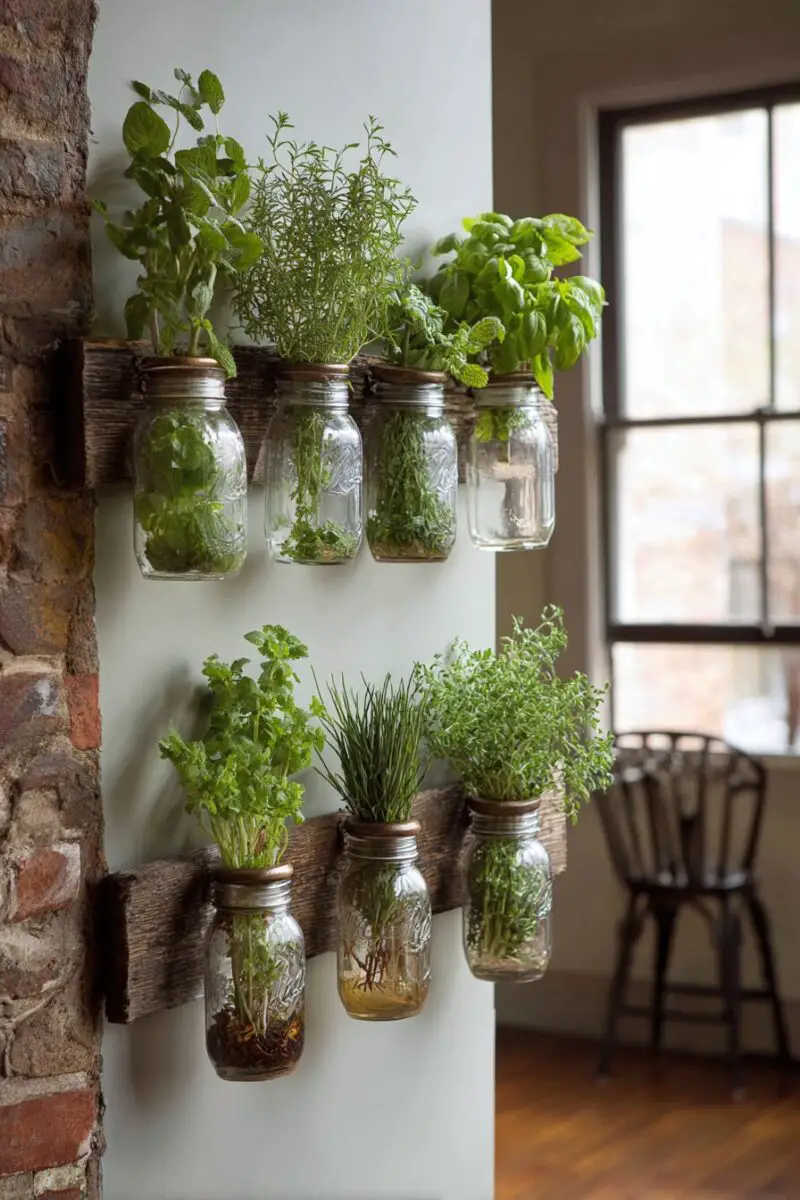
Mason jars mounted on a wooden board create a charming herb garden that adds rustic character while maximizing growing space.
This DIY approach lets you create a custom herb garden that perfectly fits your available wall space and complements your kitchen’s aesthetic.
You can arrange mason jars in geometric patterns, organic clusters, or neat rows, depending on your style preferences and the herbs you want to grow.
The clear glass containers let you monitor root development and soil moisture levels at a glance, making plant care more intuitive and successful.
Mason jar gardens work exceptionally well for propagating herbs from cuttings, as you can watch roots develop before transplanting to larger containers.
You can easily customize the mounting board with hooks, shelves, or additional storage for gardening tools and supplies.
The modular nature of this system means you can start with just a few jars and expand your collection over time without having to rebuild the entire setup.
Different sized mason jars can accommodate various herbs – small jars for delicate herbs like chives, larger ones for more substantial plants like basil or sage.
You can enhance the functionality by adding chalkboard labels directly to the jars or the mounting board, keeping track of planting dates and variety names.
This system is particularly appealing because it can incorporate both hydroponic growing (herbs rooted in water) and traditional soil-based planting in the same display.
The rustic aesthetic works well in farmhouse, industrial, or cottage-style kitchens, but can be adapted to more modern spaces with sleek mounting hardware and contemporary arrangements.
Mason jar walls are also incredibly budget-friendly, making them perfect for beginning gardeners who want to experiment with herbs without significant investment.
You can create seasonal displays by changing out herbs based on your cooking preferences or what grows best at different times of year.
The individual jar system makes it easy to quarantine sick plants or rearrange your garden layout without disturbing other herbs.
TRENDING NOW
13 Eye-Catching Fridge Decor Ideas That WowRepurposed Ladder Herb Garden for Vertical Growing Power
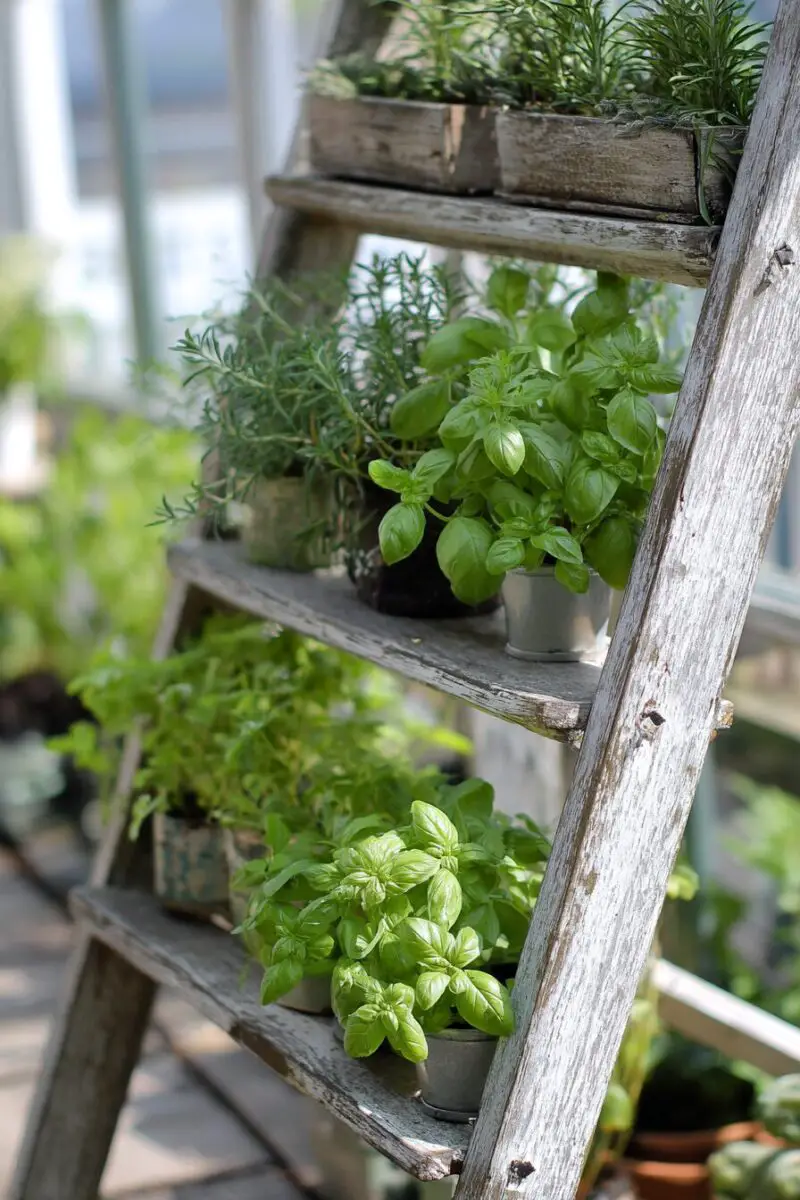
An old wooden ladder transformed into a multi-level herb garden creates stunning vertical growing space with vintage appeal.
This approach maximizes your herb growing capacity while adding unique architectural interest to your kitchen that guests will definitely notice and admire.
Each rung of the ladder becomes a shelf for planters, creating distinct growing zones that can accommodate herbs with different light and water requirements.
You can position the ladder against a wall, in a corner, or even suspended from the ceiling for a dramatic floating garden effect.
The natural spacing between ladder rungs provides excellent air circulation for your herbs, preventing common indoor growing problems like mold and pest issues.
Ladder gardens work particularly well because you can easily adjust the height and position of planters by simply moving them to different rungs as plants grow.
You can customize the setup with hanging planters, clip-on containers, or small shelves that attach to each rung, maximizing every inch of available space.
The vintage aesthetic of a ladder garden adds character to modern kitchens while providing practical growing space that would otherwise require expensive custom shelving.
Different levels naturally create microclimates – upper levels tend to be warmer and brighter, perfect for sun-loving Mediterranean herbs, while lower levels stay cooler and shadier for delicate greens.
You can enhance the functionality by wrapping small grow lights around the ladder frame, ensuring adequate illumination for all levels regardless of natural light availability.
The portability of most ladder gardens means you can move the entire setup to different locations as seasons change or your kitchen layout evolves.
This system is particularly effective for herbs that benefit from companion planting, as you can group compatible varieties on the same level.
For safety, make sure your ladder is securely positioned and can handle the weight of multiple soil-filled planters plus water.
The visual impact of a well-planned ladder garden is impressive enough to serve as a living centerpiece that showcases your gardening skills.
TRENDING NOW
13 Genius Fridge Organization Ideas You NeedKitchen Island Herb Integration for Seamless Growing
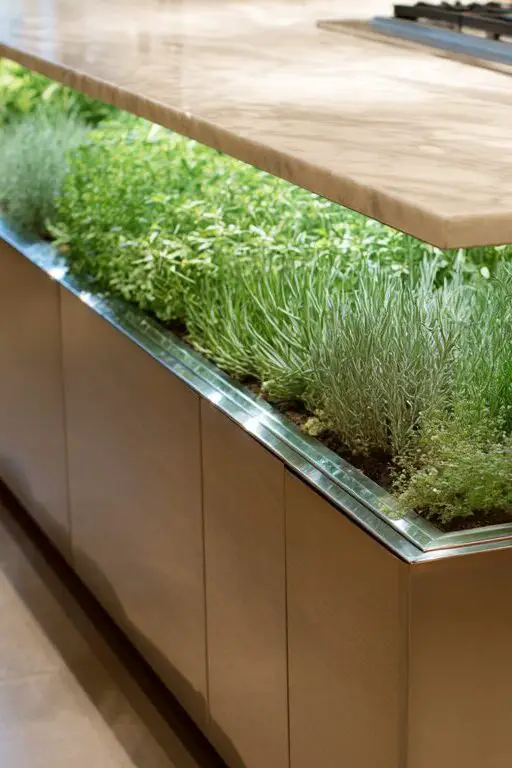
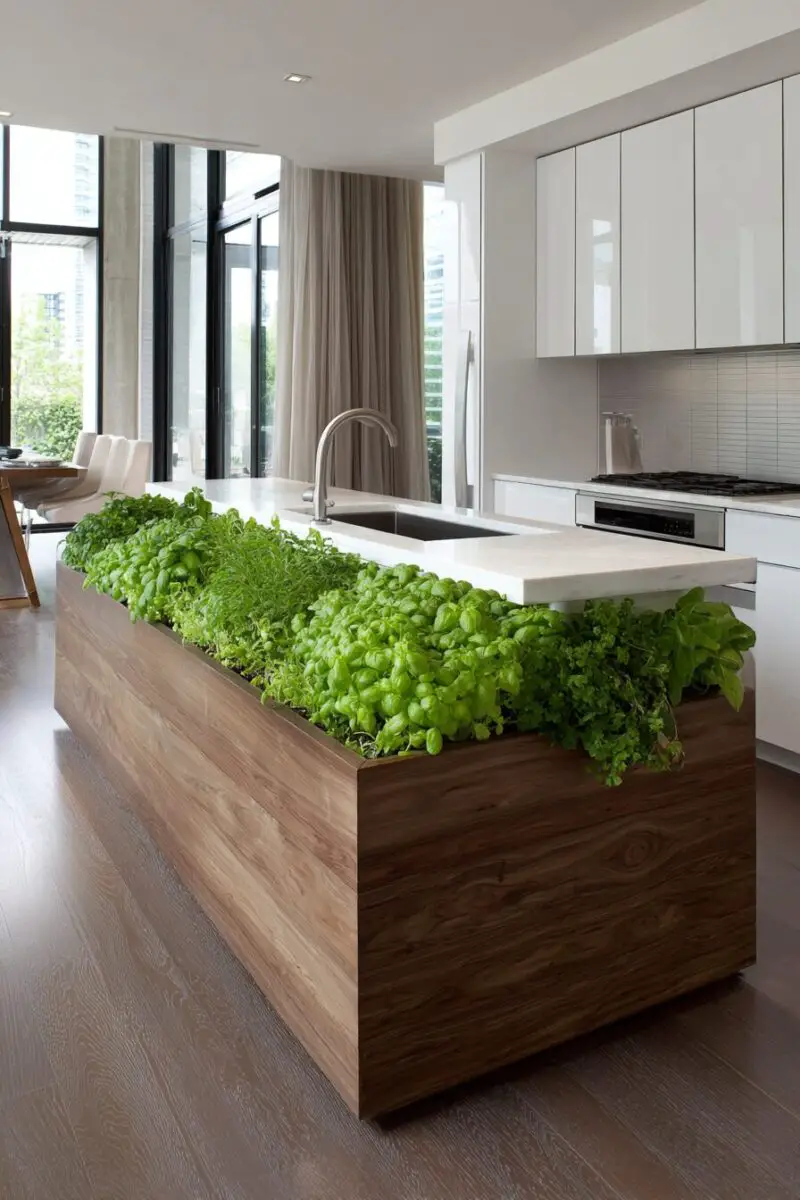
Integrating herb growing directly into your kitchen island creates a seamless garden that becomes part of your cooking workspace.
This approach works whether you’re installing a new island or retrofitting an existing one with built-in growing areas that don’t compromise functionality.
You can incorporate herb growing into an island through built-in planters, pull-out growing drawers, or dedicated sections with proper drainage and lighting.
The central location of an island means your herbs are always within easy reach while you’re preparing meals, making cooking with fresh herbs more natural and frequent.
Island herb gardens can be designed with different zones for different types of herbs – perhaps a sunny side for Mediterranean varieties and a shadier section for delicate greens.
Built-in grow lights can be incorporated into the island’s design, providing consistent illumination that keeps herbs thriving regardless of natural light conditions.
You can design the growing area with removable inserts that make cleaning and replanting easy while protecting the island’s structure from water damage.
The integration approach allows you to include features like built-in watering systems, temperature controls, and even small composting areas for herb trimmings.
This setup is particularly effective because it puts herbs at the perfect working height for harvesting and care, reducing the bending and reaching required with other growing methods.
You can incorporate storage for gardening tools and supplies directly into the island design, keeping everything you need for herb care in one convenient location.
The visual integration of herbs into your island creates a professional kitchen aesthetic that showcases your commitment to fresh, high-quality cooking ingredients.
For islands with seating areas, herb gardens add a natural, living element that makes dining more pleasant and connects people with their food sources.
This approach works particularly well in open-concept homes where the kitchen island serves as a focal point that guests and family members naturally gather around.
The investment in island integration pays off in both functionality and property value, as built-in growing systems are increasingly desired features in modern kitchens.
Ceiling-Mounted Herb Garden for Overhead Growing Space
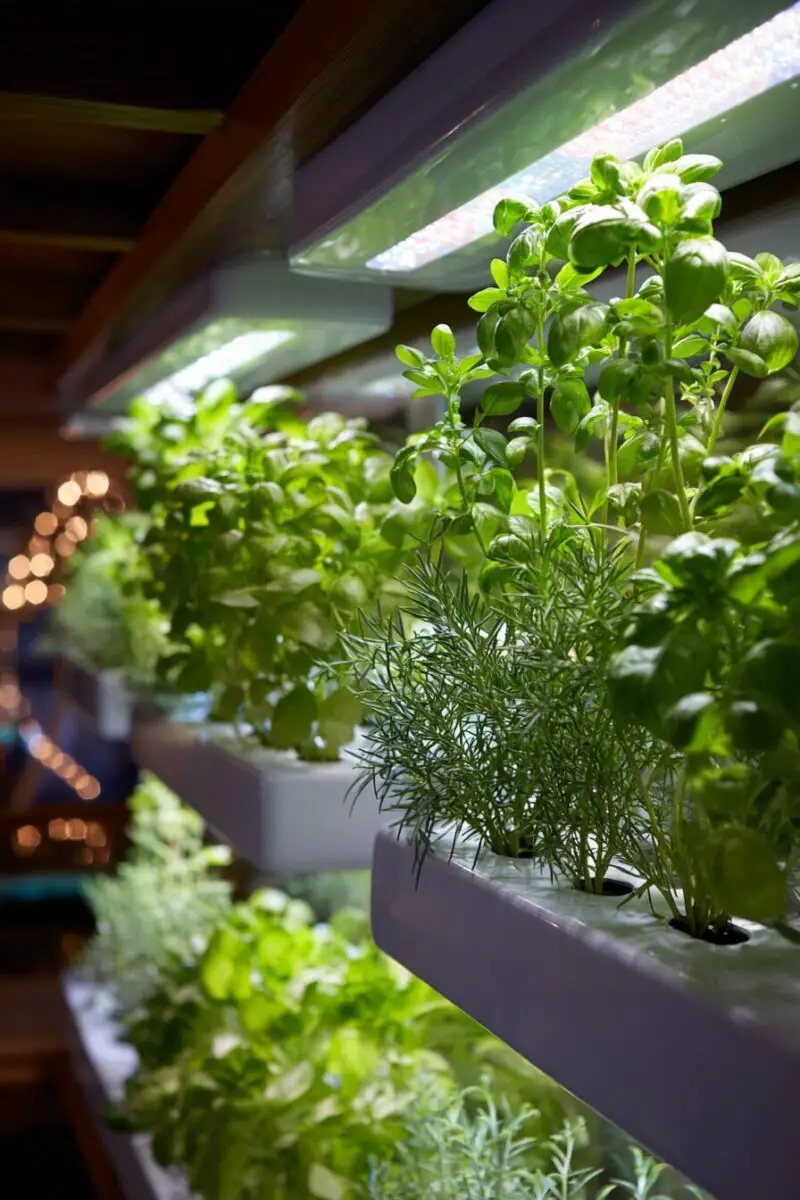
Your kitchen ceiling represents completely untapped growing real estate that can house a thriving herb garden without using any floor or counter space.
Ceiling-mounted systems work particularly well in kitchens with high ceilings or exposed beams that can support the weight of multiple planted containers.
You can install pulley systems that allow you to raise and lower your herb garden for easy maintenance while keeping it out of the way during cooking.
Overhead gardens create dramatic visual interest while providing practical growing space that’s illuminated by both natural and artificial light sources.
The elevated position means your herbs get excellent air circulation and are completely protected from cooking splatters and kitchen traffic.
Ceiling systems work exceptionally well for trailing herbs like oregano, thyme, and cherry tomatoes that can cascade down beautifully while you cook below.
You can design the system with multiple tiers at different heights, creating a layered garden effect that maximizes growing space while maintaining visual appeal.
Proper installation with appropriate anchors and support systems is crucial for safety, but once installed, ceiling gardens are incredibly stable and long-lasting.
The overhead position makes this system ideal for herbs that you use less frequently but want to keep handy, such as medicinal herbs or specialty cooking varieties.
Automated watering systems work particularly well with ceiling gardens, as you can install drip irrigation that waters all plants without requiring you to climb up regularly.
LED grow lights can be integrated directly into the ceiling mounting system, providing supplemental lighting that keeps herbs healthy year-round.
This approach is particularly effective in galley-style kitchens where wall and counter space is limited but ceiling height provides opportunities for creative growing solutions.
The unique nature of overhead herb gardens makes them excellent conversation starters and showcases your innovative approach to small-space gardening.
For seasonal variety, you can design the system with interchangeable components that allow you to swap out different herbs throughout the year.
TRENDING NOW
13 Black And Wood Kitchen Designs To InspireCompact Countertop Herb Tower for Maximum Efficiency
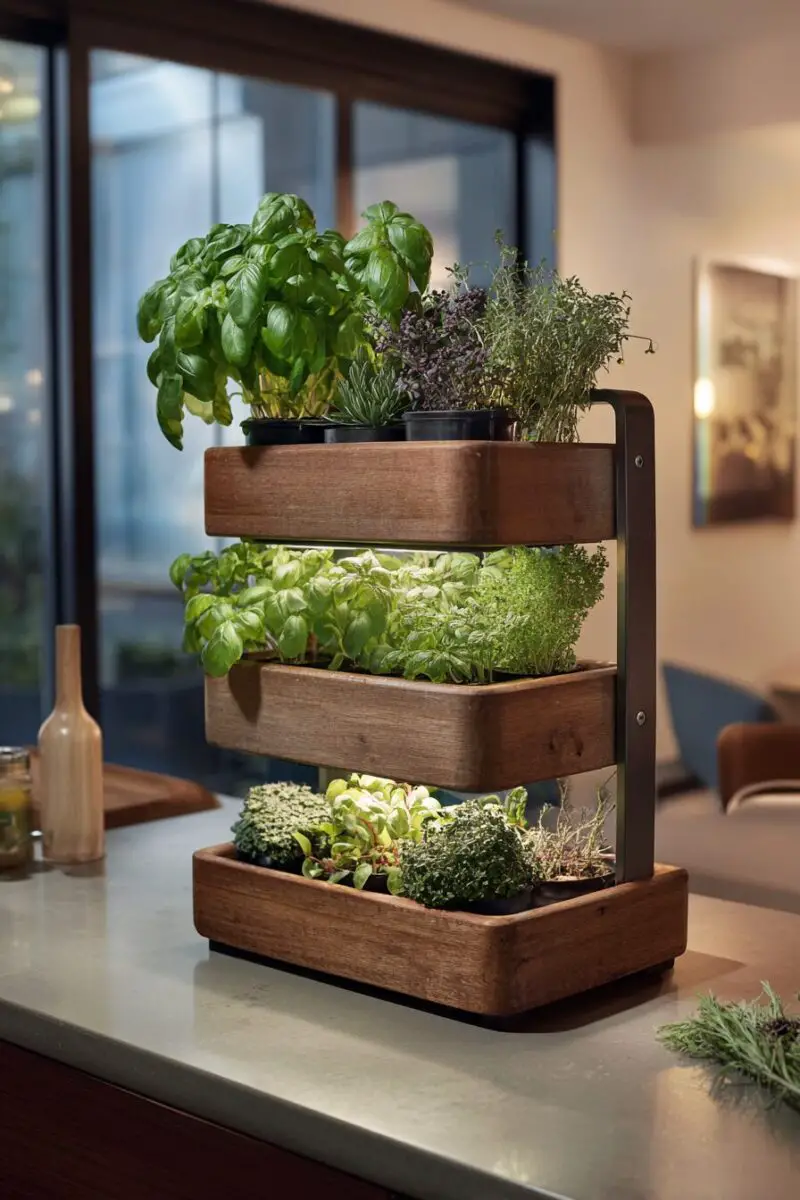
A vertical herb tower on your countertop delivers maximum growing capacity in minimal floor space while keeping herbs at perfect harvesting height.
These self-contained systems typically feature multiple growing levels stacked vertically, allowing you to grow 8-12 different herb varieties in the footprint of a coffee maker.
Modern tower systems often include built-in LED grow lights, automatic watering systems, and proper drainage, making herb growing almost foolproof for beginners.
The compact design means you can position your tower wherever it works best – next to the stove for cooking herbs, by the window for natural light, or on an island for central access.
Tower gardens work particularly well for herbs that don’t require deep root systems, such as basil, cilantro, parsley, chives, and various lettuce varieties.
The vertical design creates natural separation between different herbs, preventing more aggressive growers from overwhelming delicate varieties.
Many tower systems feature rotating capabilities, ensuring all plants receive equal light exposure and making maintenance and harvesting more convenient.
The self-contained nature of these systems means you don’t have to worry about water damage to your counters or complicated installation procedures.
You can easily move tower gardens to different locations as your kitchen needs change or as you discover optimal growing conditions for your herbs.
The modern aesthetic of most tower systems complements contemporary kitchen designs while providing obvious functionality that guests and family members immediately understand and appreciate.
Advanced tower systems include smart features like app connectivity, automatic nutrient dosing, and growth tracking that makes herb gardening feel more like a fun tech project than a chore.
The investment in a quality tower system often pays for itself quickly through reduced grocery herb purchases and the superior freshness of home-grown varieties.
For small households, tower gardens prevent waste by allowing you to harvest only what you need while keeping the rest of the plant growing and fresh.
Growing fresh herbs in your small kitchen isn’t just possible – it’s one of the most rewarding ways to enhance both your cooking and your living space.
These creative solutions prove that you don’t need a large kitchen or extensive gardening experience to enjoy the luxury of fresh herbs year-round, and the satisfaction of snipping your own basil for tonight’s pasta sauce is worth every bit of effort you put in.

